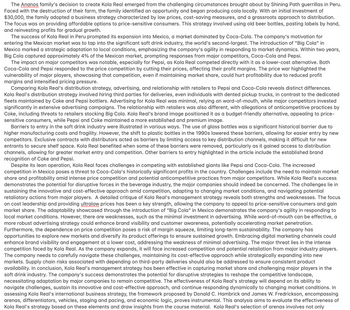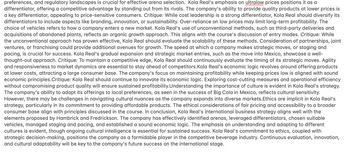
Hi. Do this make sense regarding How did the Ananos family decide to make and market Kola Real? What business strategy did this start-up company adopt? Was it successful? Explain. What motivated Kola Real to expand into Mexico? Who are its major competitors? How have those competitors been affected by Kola Real? Why could competition hurt the profitability of Pepsi and Coca-Cola even if the two companies were able to maintain their market share? Compare and contrast Kola Real's distribution strategy, advertising, and its relationship with retailers as compared to Pepsi and Coca-Cola. How is Kola Real's brand image perceived in comparison with Pepsi and Coke? Sometimes companies face barriers to entry in marketing and manufacturing a product. Why was the use of glass bottles a significant barrier to entry? How can exclusive contracts with distributors act as a barrier to entry? Are there any other barriers to entry illustrated in the article? How did Kola Real benefit when some of the barriers to entry were removed? Despite its lean operation, what challenges does Kola Real face as it tries to compete with Pepsi and Coca-Cola? Do you think the major company should be worried? Explain. Be sure to provide a detailed analysis and critique about Kola Real's management's strategy and their effectiveness using what you have learned in the course.


Trending nowThis is a popular solution!
Step by stepSolved in 5 steps

- Identify a Malaysian franchise company and an• international franchise company with the greatest potential for you to be part of in starting your own franchise business. Evaluate the opportunities by comparing the selected two franchise companies :through these questions ?What type of business or industry interests you• This is in keeping with the general concept that you. should do something that you are actually interested in, .or something that you love What are the industries that have good or excellent• ?growth potential Naturally, you would want to steer clear of industries• that have no hope of becoming more profitable in the .future How feasible is the type of business in your specific• ?location or geographic area Of course, even if a certain type of business has. massive growth potential, if it won't work in the area where you plan on setting up shop, you still won't be .able to fully realize that potentialarrow_forwardAs the pandemic scenario spread over the world, Bazinga Ltd.'s business, like most others, suffered a setback. Bazinga Ltd. is a hypermarket, discount department store, and grocery store retail chain. Mr. Manish Goel launched the retail chain in 2001, and the company has developed significantly since then. Mr. Goel had been encouraged by a number of business gurus, including his own son, a London-based business graduate, to sell things via an online website in order to expand their reach. Mr. Goel had his own worries about this channel and, as a result, he always puts off deciding. The pandemic and the current terrible situation compel Arvind to think and act in the indicated route. But he is unsure how he will go with a personnel and firm that is accustomed to a brick-and-mortar model of operation. He intends to prepare his personnel for the shift by training and developing them. Ques. Discuss each phase of the training process in terms of training and developing Bazinga's staff, in…arrow_forwardWhich one are di advantages and disavantages of APPLE INC. as a PUBBLIC LIMITED COMPANY?arrow_forward
- Why do you think Disney moved from offering one service to Premier Access? Defend your answer. What are the key components of creating a new framework for Interflix to launch a new service? What can Interflix learn from Disney’s Premier Access launch? Analyze the pros and cons as well as the unintended consequences.arrow_forwardBased on the articles on the following links"Griffin, K (2023) The Tupperware party is over. [Online] Available from: https://www.dailymail.co.uk/news/article11960521/The-Tupperware-party-iconic-brand-faces-collapse-77-years.html [Accessed April 2023 McCarthy K, (2023) Tupperware could go out of business, here’s why. [Online] Available from: https://abcnews.go.com/GMA/Food/tupperware-business/story? id=98495624#:~:text=Tupperware also chalked up lower,cash management and possible layoffs [Accessed April 2023] president and CEO Miguel Fernandez said the company has "embarked on a journey to turn around our operations" and "is doing everything in its power to mitigate the impacts of recent events -- taking immediate action to seek additional financing and address our financial position." Discuss in detail the role of Miguel Fernandes in the effectiveness of Tupperware’s turnaround strategy.arrow_forwardTop managers at Reebok looked at what Nike, New Balance, and smaller athletic shoe manufacturers like Majestic were doing to reach their chosen target markets and decided upon comparison that it wanted to risk targeting the hip-hop market. Reebok’s strategy is much more like the one implemented by New Balance. Unlike Nike, neither Reebok nor New Balance uses athletes as spokespeople for its products. Therefore, Nike would be an example of a _____, and New Balance would be an example of a _____ for Reebok. A. core firm; secondary firm B. secondary firm; core firm C. transient firm; secondary firm D. transient firm; core firm E. secondary firm; transient firmarrow_forward
- What types of unique marketing support helped to sustain Vitaminwater and Bai’s tremendous growth?arrow_forwardI need help with this problem for my Strategic Management class. Thank you What do you feel are some of the ways that Harley Davidson can overcome obstacles to do a better job of appealing to younger consumers? Also, how might the pandemic and associated economic downturn necessitate changes in HD's strategy and business model? Why?arrow_forward
 Understanding BusinessManagementISBN:9781259929434Author:William NickelsPublisher:McGraw-Hill Education
Understanding BusinessManagementISBN:9781259929434Author:William NickelsPublisher:McGraw-Hill Education Management (14th Edition)ManagementISBN:9780134527604Author:Stephen P. Robbins, Mary A. CoulterPublisher:PEARSON
Management (14th Edition)ManagementISBN:9780134527604Author:Stephen P. Robbins, Mary A. CoulterPublisher:PEARSON Spreadsheet Modeling & Decision Analysis: A Pract...ManagementISBN:9781305947412Author:Cliff RagsdalePublisher:Cengage Learning
Spreadsheet Modeling & Decision Analysis: A Pract...ManagementISBN:9781305947412Author:Cliff RagsdalePublisher:Cengage Learning Management Information Systems: Managing The Digi...ManagementISBN:9780135191798Author:Kenneth C. Laudon, Jane P. LaudonPublisher:PEARSON
Management Information Systems: Managing The Digi...ManagementISBN:9780135191798Author:Kenneth C. Laudon, Jane P. LaudonPublisher:PEARSON Business Essentials (12th Edition) (What's New in...ManagementISBN:9780134728391Author:Ronald J. Ebert, Ricky W. GriffinPublisher:PEARSON
Business Essentials (12th Edition) (What's New in...ManagementISBN:9780134728391Author:Ronald J. Ebert, Ricky W. GriffinPublisher:PEARSON Fundamentals of Management (10th Edition)ManagementISBN:9780134237473Author:Stephen P. Robbins, Mary A. Coulter, David A. De CenzoPublisher:PEARSON
Fundamentals of Management (10th Edition)ManagementISBN:9780134237473Author:Stephen P. Robbins, Mary A. Coulter, David A. De CenzoPublisher:PEARSON





